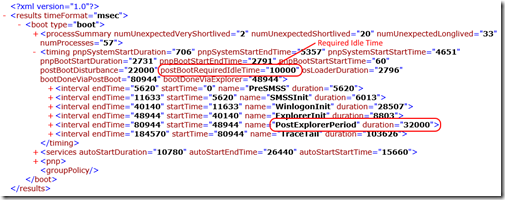Windows Enterprise Client Boot and Logon Optimization – Part 15, Boot Phase – Post Boot
This post continues the series that started here.
Today I’ll be covering the last of our boot and logon phases – Post Boot.
Boot Phase Post Boot – Phase Activity
While not technically a phase, Post Boot represents the period after Explorer Initialization where the system is too busy for use.
The phase ends once the system has accumulated 10 seconds where both disk and CPU are greater than 80% idle. During this time, services continue to start and auto-start applications are launching.
Boot Phase Post Boot – Measurement
As with all other phases I’ve discussed, the summary XML generated with xperf.exe provides duration as PostExplorerPeriod –
The difference here is that the phase duration includes the 10 seconds of accumulated idle time. In the example above, the real length of PostExplorerPeriod is 32 – 10 = 22 seconds.
Once again, the Regions of Interest graph also shows this duration as Post Boot: –
Boot Phase Post Boot – Potential Issues
As I’ve already mentioned, the phase is entirely related to having the system arrive at an idle state so the user can start working. Anything that contends for CPU or Disk is a potential issue –
- Services continuing to start
- Auto-start applications launching from run keys or the user start up folder
- Instant messaging clients are a common contributor
- ReadyBoot may continue to pre-fetch data if the boot footprint is large
- Antivirus may contend for resources
The overall user experience may include problems such as –
- Mouse/keyboard unresponsiveness
- Slow application launch
- A general perception of lag
Boot Phase Post Boot – Potential Issues
In order to isolate issues, zoom to the Post Boot: phase in Windows Performance Analyzer (WPA) and perform analysis of CPU and Disk Utilization (see Part 9). Also review ReadyBoot (see Part 7).
Once you identify processes that contend for CPU or Disk, try to remove them from auto-start. If they really must run, consider having them launch as delayed-start scheduled tasks.
If ReadyBoot requires optimization, proceed with optimization as discussed in Part 4.
Conclusion
Post Boot is optimized by minimizing CPU and Disk utilization. Remove unneeded auto-start applications and postpone the start of those that must run automatically.
This post concludes the review of boot phases.
Next Up


